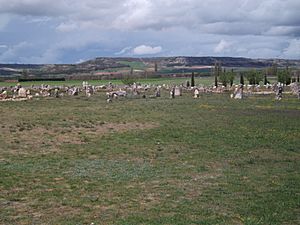Pintia facts for kids
Pintia was an ancient city in central Spain. It belonged to a group of people called the Vaccaei. Today, you can find its ruins near a town called Padilla de Duero in the Valladolid province.
The Vaccaei were one of the first groups to settle down in this area. They lived in the valleys between the Duero and Pisuerga rivers. This region now includes parts of the Valladolid, Palencia, Zamora, Segovia, and Ávila provinces.
Contents
Who Were the Vaccaei?
The Vaccaei were an early Celtic society. They arrived in this part of Europe when their culture was growing. They built several cities, like Pintia and Pallantia. These cities were almost like independent mini-countries, but they stayed connected with each other.
The Vaccaei were very loyal to their sister cities. For example, they helped the Arevaci people of Numancia. Numancia was under attack by the powerful Roman army. Because the Vaccaei helped, the Romans later conquered their cities too. This happened after the Romans won their battle at Numancia.
Pintia and the Romans
The Roman army attacked and destroyed Pintia. This event also led to the end of the Vaccaei culture, their religion, and their language. It was a big change for the region.
For many years, people thought the ancient city of Pintia was where the modern city of Valladolid is now. But archaeological digs showed this was not true. The ruins found near Padilla de Duero are now believed to be the real Pintia.
Exploring the Ruins of Pintia
The archaeological site of Pintia has three main parts. These are the city area called Las Quintanas, the burial ground known as the necropolis of Las Ruedas, and the pottery-making district of Carralaceña.
The City of Las Quintanas
Archaeologists have found that the city of Las Quintanas was destroyed by a large fire. After this, the Visigoths, another ancient group, used the area. They built their own burial ground near the old Vaccaeo-Roman city.
The Necropolis of Las Ruedas
At the necropolis of Las Ruedas, researchers have found many interesting burials. Some of these graves belonged to important elderly soldiers. These burials often contained valuable items.
The Potter's District of Carralaceña
Near the town of Pesquera de Duero, they found the Carralaceña district. This was where artisans made pottery. The kilns, which are ovens for firing pottery, produced a huge amount of goods. Because of the risk of fires, these kilns were built across the river. This created a separate district next to the cemetery.
The kilns found here are very special and unique in Europe. However, you cannot visit them yet. The local government does not think it would be worth the cost to open the site for tourists.
Protecting and Studying Pintia
Sadly, some parts of the ancient town were damaged. This happened when vineyards were planted because there wasn't enough support for the excavation projects.
Today, the University of Valladolid is working to recover and study the town. Every summer, students from around the world help excavate the necropolis at Pintia. They work under the guidance of the University of Valladolid and the Federico Wattenberg Center of Vaccean Studies. ArchaeoSpain helps make these field schools possible.
See also
 In Spanish: Pintia para niños
In Spanish: Pintia para niños


